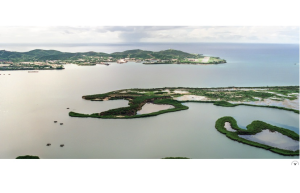FREE FLOW OF INFORMATION
Based on an article by Joe Roman and James Kraska in Science magazine
As US president Obama makes a visit to Cuba, the following opinion has been published by Science, the journal of the American Association for the Advancement of Science: “The United States should deliver on President Obama’s recent plan to close the military prison at U.S. Naval Station Guantánamo Bay and repurpose the facilities into a state-of-the-art marine research institution and peace park, a conservation zone to help resolve conflicts between the two countries. This model, designed to attract both sides . . . could unite Cuba and the United States in joint management, rather than serve as a wedge between them, while helping meet the challenges of climate change, mass extinction, and declining coral reefs.”

Mangroves dot Guantánamo Bay with the U.S. naval base airstrip seen in the distance. Photo by Luke Frazza/AFP/Getty Images
The authors are Joe Roman, a conservation biologist at Vermont University and James Kraska, a law professor at the US Naval War College.
They suggest it could become ” ‘a “Woods Hole of the Caribbean,” housing research and educational facilities dedicated to addressing climate change, ocean conservation, and biodiversity loss.”
Both Cuba and the United States have strong interests in preserving the marine environment. The Woods Hole Marine Biological Laboratory, located on Cape Cod in the United States, is recognized as one of the leading scientific institutions of its typle in the world. And, according to the authors, Cuba has taken strong measures to preserve its coral reefs and coastal waters since the 1992 Earth Summit in Rio de Janeiro, They have developed “extensive protected areas, a constitution with strong environmental provisions, and an aggressive stance on climate change, putting it at the center of Caribbean conservation efforts. It has established the largest marine park in the Caribbean, the Jardines de la Reina (Gardens of the Queen), with abundant sharks and groupers.”
Tha authors place their proposal in the context of peace parks: “The world’s first peace park is the Water-ton-Glacier International Peace Park on the border of Canada and the United States, a symbol of goodwill between the countries. There have been successful transitions from military bases and conflict zones in other countries. After the United States left Fort Clayton to Panama, for example, part of the base was transformed into Ciudad de Saber (City of Knowledge), a government-sponsored complex that has attracted international scholars and the United Nations Development Program. Although the future of land along the corridor of the former Iron Curtain is uncertain, the European Green Belt initiative could transform the continent and help species such as lynx, brown bears, and imperial eagles recover. Such international parks are signs that humans can respect each other, even after conflicts, and protect other species that share our planet.”
They conclude that “the Guantánamo peace park and research center would encourage nations to convert military bases and conflict zones into areas of creativity, cooperation, and biodiversity conservation. For the next generation, the name Guantánamo could become associated with redemption and efforts to preserve and repair international relations and the planet.”
Peace parks: Are they promoting peace?
See also The Contribution of Transfrontier Peace Parks to Peace in Southern Africa.